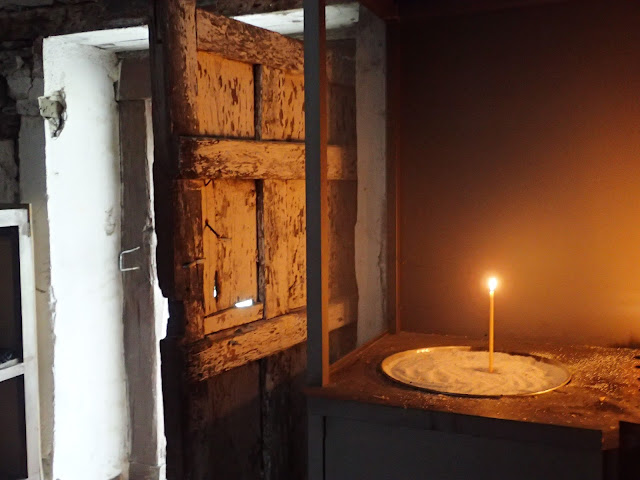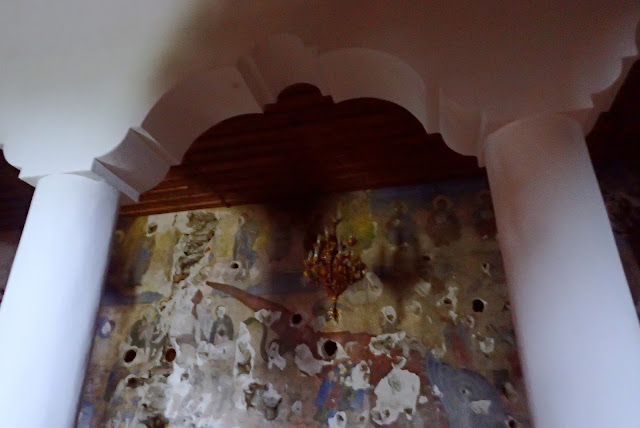Rural Northern Greece is full of things to discover- one hidden secret thing after the next. After a long hike you might come upon a church in the dense fog, the yard a little overgrown.
You'd never expect to find it open. There is no priest, no cars nearby, no tire tracks in the mud. But when you go in, a candle is flickering. The melting beeswax fills the damp air.
This is Agios Ioannis, crowded on his St. day (John, the 7th of January), and in solitude the rest of the year. In the 1850's, toward the end of the Ottoman Empire, there was a restlessness; reforms that loosened things up. The Hatt-ı Hümayun was an Ottoman reform edict of 1856 that ensured a new degree of religious tolerance, granting Christians permission to build new Churches. The devout of Almopeia went on a building spree- all the churches we will visit on our trip are from this period. Sharing craftsmen, they are also similar.
The walls and columns are white and gather the light softly from small windows,
We are all struck by how Mission style Spanish the arches look- an unusual shape in an Orthodox church. And the chandelier is dense like a Faberge egg.
The outer walls, frescoed, are in darkness.
They are full of holes, clearly systematically opened in the plaster. There are three reasons for this- two of them we'd never guess. But we're fortunate to be in the hands of a very well informed guide, Nikos Zacharakis, whose broad and sometimes obscure knowledge illuminated our trip. One reason for the damage to the frescoes- pigment from the icons themselves was thought a folkloric medicine- people would chip the surface away, dilute it in water and drink it(!). Some of the holes are neat and perfectly round- these were made to hold glass jars- low tech speakers (αντηχεία- "antiheia") which would draw the sound to the edges of the church. The third? Especially after the Greek civil war (1946-1950) thieves would knock on the plaster, find a hollow sound, and rip it open in search of gold that people would sometimes hide in the walls of a church.
Through an opening in the wooden screen, we can see the Altar where the priest prepares the sacrament- a rare glimpse.
The afternoon brought us to another church, known for its excellent carving. The intricate, folkloric altar seems nearly crammed into its niche-
as though they got carried away when carving it.
Even the less spare of the churches had a rustic splendor. Agios Dimitrios with its large covered porch is spare and humble on the outside,
a veritable jewelbox within, hardly a surface left untouched (look at the candy-striped columns!)
I live in a city known for Byzantine Churches. The thing that makes the churches of Almopeia so special is their very remoteness. This is the theme of our trip, exploring the interplay of nature and art though a program called living history, living nature. In the woods of Almopeia, what looks all but abandoned to the elements is filled with history and life. Also, the Churches of a city, even the very oldest, have an urban feel. No matter how ornate, the ornamentation has order, polish. Almopeia's churches have the wild exuberance of rustic craftsmanship and rugged nature- very much of their landscape, but at the same time, simply astonishing to come upon in the fog.
Even the less spare of the churches had a rustic splendor. Agios Dimitrios with its large covered porch is spare and humble on the outside,
a veritable jewelbox within, hardly a surface left untouched (look at the candy-striped columns!)
I live in a city known for Byzantine Churches. The thing that makes the churches of Almopeia so special is their very remoteness. This is the theme of our trip, exploring the interplay of nature and art though a program called living history, living nature. In the woods of Almopeia, what looks all but abandoned to the elements is filled with history and life. Also, the Churches of a city, even the very oldest, have an urban feel. No matter how ornate, the ornamentation has order, polish. Almopeia's churches have the wild exuberance of rustic craftsmanship and rugged nature- very much of their landscape, but at the same time, simply astonishing to come upon in the fog.











Great post, Amber. Very fascinating frescoes like we talked about... I feel like I was there with you!
ReplyDelete